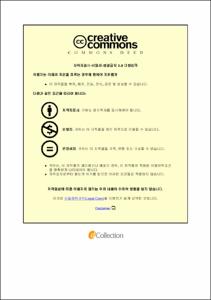블록 공중합체 마이셀을 이용한 금속 나노입자 정렬과 입자간 상호작용 제어
- Alternative Title
- Controlled Arrangements of Metal Nanoparticles and the Corresponding Coupling Effect by Block Copolymer Micelles
- Abstract
- 나노입자는 그 물질의 벌크 상태와는 전혀 다른 독특한 물리 화학적 특성을 나타내며 여러 응용 가능성을 가지고 있다.1,2,3
금속 나노입자중 금 나노 입자는 국소표면 플라즈몬 공명 (localized surface plasmon resonance, LSPR) 이라는 광학특성을 나타낸다.4,5 표면 플라즈몬에 의해 금속 나노입자는 입사광선과 강한 상호작용을 하여 주변의 전자기장을 입자 주위로 집중 시키며 국부적인 장 증폭 현상을 나타낸다.2,4 이때 금속 나노 입자간의 거리 및 형태에 따라서 광학적 특성이 달라진다. 특히 금 나노 입자의 경우 가시광선 영역에서 LSPR 특성을 나타내며 크기와 형태의 제어를 통해 LSPR 특성을 보이는 빛의 파장을 조절할 수 있다. 이러한 금 나노입자의 제어를 위해서 주로 블록 공중합체를 사용한다.
두 가지 이상의 화학적으로 구별되는 고분자들로 이루어진 블록 공중합체(block copolymers)는 작은 분자(small-molecule)의 집합체 또는 자기 조립(self-assembly) 과 같은 원리에 따라 벌크 혹은 용액 상에서 블록 공중합체의 자기 조립 이 이루어진다.
블록 공중합체를 한 블록에 대해서만 선택적인 용매에 용해시키면 용매에 용해되는 코로나(corona) 블록과 용해되지 않는 코어(core) 블록으로 상분리가 진행되며 고분자 마이셀을 형성한다.6,7,8,9 마이셀의 형태와 크기는 공중합체간의 부피분율(f), 분자량(N), 그리고 상호작용계수(Flory-Huggins interaction parameter) 등에 따라 결정되며, 20 ~ 200 nm 의 크기를 가지는 구(sphere), 실린더(cylinder), 소포(vesicles), 라멜라(lamellae) 등의 다양한 나노 구조체들을 형성한다.
또한 이러한 만들어진 마이셀 들은 다음의 중요한 요인들에 의해 그 형태가 변화될 수도 있다. 두 블록 사이의 계면 에너지 (엔탈피 조건) 와 체인 스트레칭(chain stretching) (엔트로피 조건) 에 의하여 구형과 실린더, 라멜라 로 그 형태를 바꿀 수 있다. 또한 염을 이용한 코로나 표면의 정전기적 반발력의 감소를 이용하여 응집수의 변화를 일으킬 수 있다.
이러한 코어 코로나 구조로 이루어진 마이셀 구조는 나노 입자를 안정화 시키거나 나노 입자를 합성하는데 있어 매우 유용하게 이용되고 있다.10
본 연구에서는 블록 공중합체를 이용하여 마이셀 코어에 금 나노 입자를 도입하고 이후 용액 상에서 염을 이용하여 코어에 금 나노 입자가 도입된 마이셀을 특정한 형태로 재배치를 시킨다. 이렇게 배치된 금 나노 입자는 마이셀의 크기, 용매의 조성비, 염에 따라서 선형 또는 구 형태로 배치가 된다. 이러한 금 나노입자의 정렬구조의 제어 및 구조에 따라 나타나는 플라즈몬 효과를 관찰하였다.
After 20th century, the Nano-technology has been developing in the industry. it was able to control Metal Nanoparticle's size and shape through synthesis. The Metal Nanoparticle, controlled by shape and size, can change its feature, such as electronical, chemical, optical, mechanical. it has been studying in a variety of field such as Biologic, Catalysis etc. In this study, we utilized nanostructures of polystyrene-block-poly(acrylic acid), PS-PAA, block copolymers to control the arrangement Au nanoparticles (NPs) in a solution state. Here, PS-PAA copolymers self-associate into micelles consisting of PS cores and PAA coronas, at which the repulisive interaction among PAA corona is adjusted by adding salt such as HCl to the micellar solution. This process can strongly alter the aggregation behavior of PS-PAA copolymers. By further adjusting several experimental parameters such as solvent selectivity, salt concentration, and the composition of block copolymers, the arrangmement of Au NPs in the micellar structures can be engineered in forms of one-dimensional chain or three-dimensional cluster of Au NPs.
- Issued Date
- 2016
- Awarded Date
- 2016. 2
- Type
- Dissertation
- Publisher
- 부경대학교 대학원 고분자공학과
- Alternative Author(s)
- Jang Hwan Kim
- Affiliation
- 부경대학교 대학원 고분자공학과
- Department
- 대학원 고분자공학과
- Advisor
- 유성일
- Table Of Contents
- Contents
Contents..........................................................................................................................................ⅰ
List of Figures.............................................................................................................................ⅱ
Abstract..........................................................................................................................................ⅴ
제 1 장 서론..................................................................................................................................1
제 2 장 이론적 배경
2-1. 금속 나노입자......................................................................................................................3
2-2. 표면 플라즈몬 효과............................................................................................................4
2-3. 나노입자 어셈블리..............................................................................................................6
2-4. 블록 공중합체......................................................................................................................8
2-5. 블록 공중합체 마이셀.....................................................................................................11
2-6. 블록 공중합체의 형태 전환 메커니즘.........................................................................13
제 3 장 실험
3-1. 재료......................................................................................................................................16
3-2. 금 나노입자의 합성.........................................................................................................17
3-3. 금 나노입자의 표면 개질...............................................................................................18
3-4. 블록공중합체 마이셀 코어에 금 나노입자의 도입..................................................19
3-5. Au@PS-PAA 의 재분산................................................................................................20
3-6. 금 나노입자의 정렬..........................................................................................................21
3-6-1. H2O 농도에 따른 변화..............................................................................................22
3-6-2. 분자량의 종류에 따른 변화.....................................................................................22
3-7. 측정......................................................................................................................................23
제 4 장 결과 및 고찰
4-1. 금 나노입자의 합성..........................................................................................................24
4-2. 블록공중합체 마이셀 코어에 금 나노입자의 도입..................................................26
4-3. Au@PS-PAA 의 재분산................................................................................................28
4-4. 금 나노입자의 정렬..........................................................................................................29
4-5. H2O 농도에 따른 변화....................................................................................................32
4-6. PS-PAA 분자량에 따른 변화.......................................................................................36
제 5 장 결론................................................................................................................................40
- Degree
- Master
- Files in This Item:
-
-
Download
 블록 공중합체 마이셀을 이용한 금속 나노입자 정렬과 입자간 상호작용 제어.pdf
기타 데이터 / 2.55 MB / Adobe PDF
블록 공중합체 마이셀을 이용한 금속 나노입자 정렬과 입자간 상호작용 제어.pdf
기타 데이터 / 2.55 MB / Adobe PDF
-
Items in Repository are protected by copyright, with all rights reserved, unless otherwise indicated.